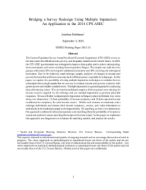
An official website of the United States government
Here’s how you know
Official websites use .gov
A .gov website belongs to an official government organization in the United States.
Secure .gov websites use HTTPS
A lock (
) or https:// means you’ve safely connected to the .gov website. Share sensitive information only on official, secure websites.
-
//
- Census.gov /
- Census Working Papers /
- Bridging a Survey Redesign Using Multiple Imputation
Bridging a Survey Redesign Using Multiple Imputation: An Application to the 2014 CPS ASEC
Bridging a Survey Redesign Using Multiple Imputation: An Application to the 2014 CPS ASEC
Introduction
The Current Population Survey Annual Social and Economic Supplement (CPS ASEC) serves as the data source for official income, poverty, and inequality statistics in the United States. In 2014, the CPS ASEC questionnaire was redesigned to improve data quality and to reduce misreporting, item nonresponse, and errors resulting from respondent fatigue. The sample was split into two groups, with nearly 70% receiving the traditional instrument and 30% receiving the redesigned instrument. Due to the relatively small redesign sample, analyses of changes in income and poverty between this and future years may lack sufficient power, especially for subgroups. In this paper, we explore the possibility of using multiple imputation techniques to combine the two subsamples into a single sample that we can use to estimate income and poverty statistics with greater power and smaller standard errors. Multiple imputation is a general approach to analyzing data with missing values. We can treat the traditional sample as if the responses were missing for income sources targeted by the redesign and use multiple imputation to generate plausible responses. We use a flexible semiparametric imputation technique to place individuals into strata along two dimensions: 1) their probability of income recipiency and 2) their expected income conditional on recipiency for each income source. Within each stratum, we randomly select redesign individuals and donate their income recipiency, source, and value information to individuals in the traditional sample as the imputed data. By matching on these two dimensions this approach combines the ideas of propensity score matching (from the probability of recipiency strata) and predictive means matching (from expected income strata). In this paper, we implement this approach, use diagnostics to evaluate the matching models, and analyze the results.
Others in Series
Working Paper
Working Paper
Working Paper
Share
Some content on this site is available in several different electronic formats. Some of the files may require a plug-in or additional software to view.
 Yes
Yes
 No
NoComments or suggestions?


Top

